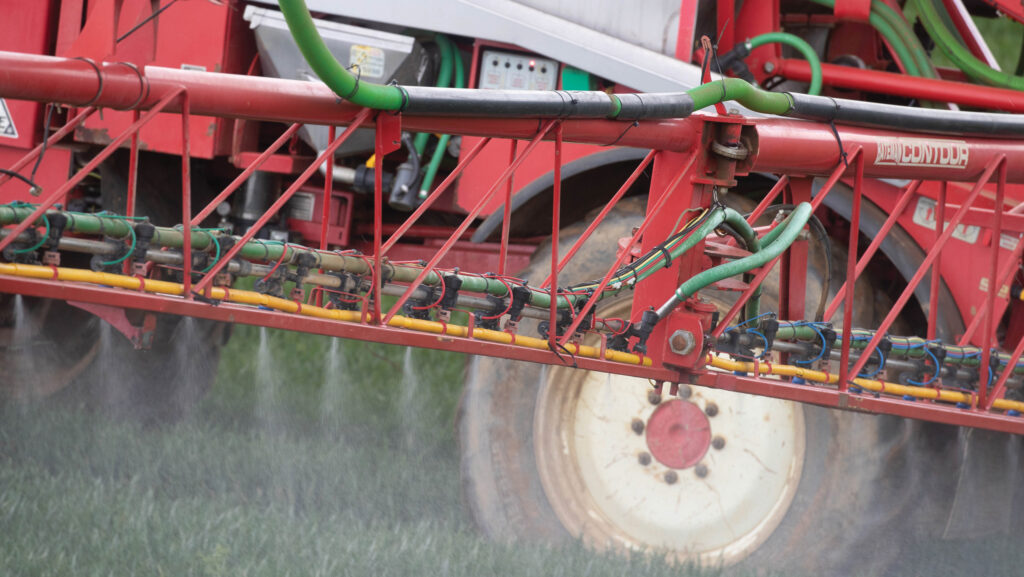Endophytes raise wheat yields by 0.6t/ha in trials
 © Tim Scrivener
© Tim Scrivener Applying an endophyte that takes nitrogen from the air and converts it to nitrate within the plant’s leaves increased wheat yields by 0.6t/ha, according to trials.
Research also suggested that yields could have been even higher with top-up foliar micronutrition.
See also: How farmers will benefit from new SDHI wheat fungicide at T2
Endophytes have been around for some time, but the past two years have seen much more interest as nitrogen fertiliser prices went through the roof.
Agrii fertiliser trials manager Jim Carswell explains that endophytes are bacteria or fungi that live within the plant for at least part of their life cycle without causing apparent disease or harm to the host.
Some of these can fix nitrogen in plant leaves, and one product was trialled last year across 15 different wheat varieties.
There were three different treatments:
- Farm standard N rate + no BlueN (total 212 kg/ha of nitrogen (N))
- Farm standard N rate with BlueN (total 212 kg/ha of N)
- Reduced rate (30 kg/ha of N less) with BlueN (total 182 kg/ha of N).
Nitrogen fertiliser was applied in three different splits. The first two were the same across all treatments and the third split saw rates varied. The BlueN was applied at growth stage 32.
Results showed that there was a 0.6t/ha increase in yield when using BlueN and sticking with the farm standard nitrogen rate, above the control at 13.08t/ha.
The reduced nitrogen rate only saw a 0.05t/ha reduction, so the endophyte successfully maintained yield.
Grain analysis
Since then, fertiliser prices have eased back. Jim believes the product still has a use when farmers have reached N-max and are looking to drive plants hard, to gain extra yield.
Looking at grain quality, specific weight tended to be higher when using the endophyte.
However, there was a grain protein dilution, so the product is more suited to feed wheat situations where protein content is less critical.
Grain nutrient analysis suggested that there may have been shortages of iron and molybdenum, and soil testing backed this up.
Jim says soils were very dry in June and affected iron availability. This, coupled with below optimal soil molybdenum levels, may have had a knock-on effect.
“We could have possibly seen a higher response if molybdenum was topped up later in the season.”
He explains that there are three forms of nitrogenase:
- Molybdenum
- Vanadium
- Iron.
Molybdenum nitrogenase is the most effective N fixing enzyme, three times more effective than iron nitrogenase, with the vanadium somewhere in the middle.
He explains that where there is a shortage of molybdenum, the plant produces the other forms in their place.
Therefore, if farmers use the endophyte, he suggests they focus on micronutrition to get the most out of it.
“We may need to be more proactive in identifying any potential issues before they occur,” he says.
Work is ongoing and the new glasshouse facility at Throws Farm will enable Jim to look at micronutrients in closer detail.
This may include a molybdenum coating on fertiliser or a micronutrient foliar top-up in season.
Top tips on use
There is a range of different endophyte products on the market and they all have different effects on plants.
For example, some increase the bioavailabilty of nitrogen by fixing atmospheric nitrogen, or increase phosphorus bioavailability by sequestering it from soil.
It could also be increasing water use efficiency or helping plants cope with stress.
Therefore, Jim Carswell advises farmers to be clear on what they are hoping to achieve from using their product.
Farmers are also advised to read the label as they all have different instructions for use.
For example, there are two endophytes that fix nitrogen in plant leaves, but Nientris can be applied at stem extension, while BlueN is to be applied later at growth stage 32.
There are other factors, including water temperature (above 5C) and the presence of chlorine, that can affect some products.
Another key factor is having good agitation in the sprayer. “You are using quite small quantities – 50g/ha – so you need good mixing,” Jim says.
Conditions also need to be optimal when applying endophytes. For example, is the crop actively growing, is there sufficient leaf area for uptake and are the stomata open?
And finally, beware of antibacterials in tank mixes. He suggests farmers refer to the manufacturer’s approved mixing list.

